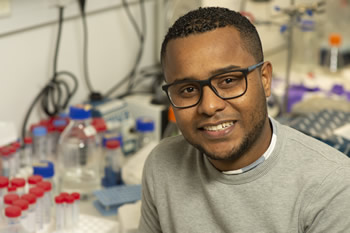- This event has passed.
RNA Faculty Candidate Seminar: Jailson (Jay) Brito Querido, MRC Laboratory of Molecular Biology
Monday, January 31, 2022 @ 4:00 pm - 5:00 pm
 “The scanning mechanism of mRNA translation initiation in humans”
“The scanning mechanism of mRNA translation initiation in humans”
Jailson (Jay) Brito Querido, Ph.D.
Postdoctoral Scientist
MRC Laboratory of Molecular Biology
Cambridge, UK
Co-Hosts: The Center for RNA Biomedicine, Department of Biological Chemistry, and the Program in Biophysics
Hybrid Seminar:
In-person: Biomedical Science Research Building (BSRB), ABC Seminar rooms
Zoom: https://umich.zoom.us/webinar/register/WN_pcS-fWIdSS-hDnKzoRhXeg
Keywords: mRNA, translation, ribosome, helicase
Abstract: Decoding the genetic information into protein is fundamental for all kingdoms of life. It requires precise mechanisms to transcribe the DNA into mRNA, which then can be translated by the ribosome to produce proteins. Translation initiation of eukaryotic mRNAs is a dynamic process regulated by over a dozen protein eukaryotic initiation factors (eIFs). This process starts with the binding of eukaryotic initiation factors eIF1, eIF1A, eIF3, eIF5, and a ternary complex of eIF2–GTP–tRNAiMet (TC) to the 40S small ribosomal subunit, forming the 43S preinitiation complex (43S PIC). Once assembled, the 43S PIC is recruited to the 5′ untranslated region (UTR) of mRNA by the multifactor cap-binding complex eIF4F, forming the 48S initiation complex (48S). The 48S then scans along the 5′ UTR mRNA to locate a start codon. The eIF4F binding site in the 48S and how mRNA is inserted into the mRNA channel in the 40S small ribosomal subunit remained unknown. To gain insights into the molecular mechanism underlining the assembly of the 48S, we used cryo-electron microscopy to determine the structure of a reconstituted human 48S. The structure sheds light on the early events of translation initiation complex assembly, including how eIF4F interacts with the 43S during the scanning process.

